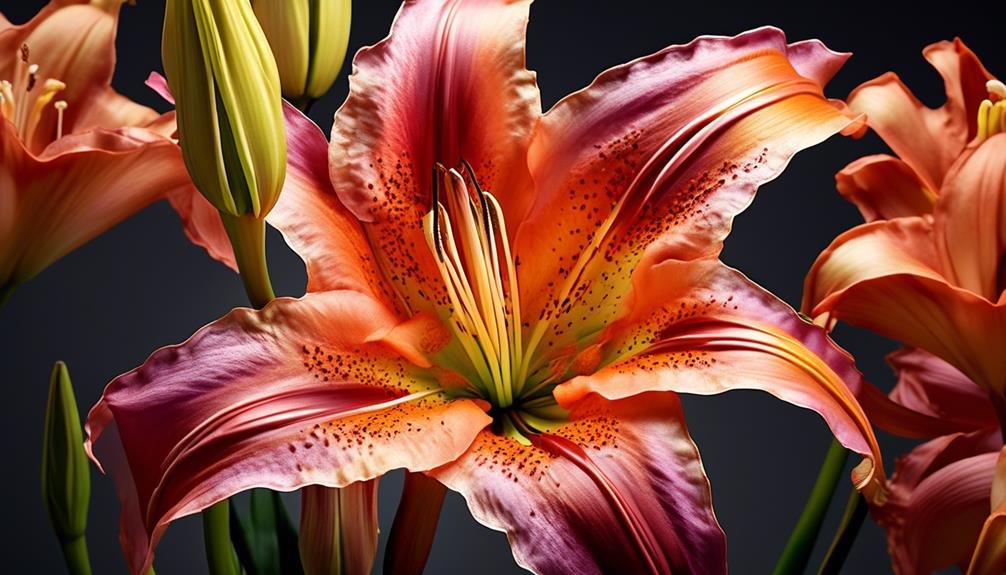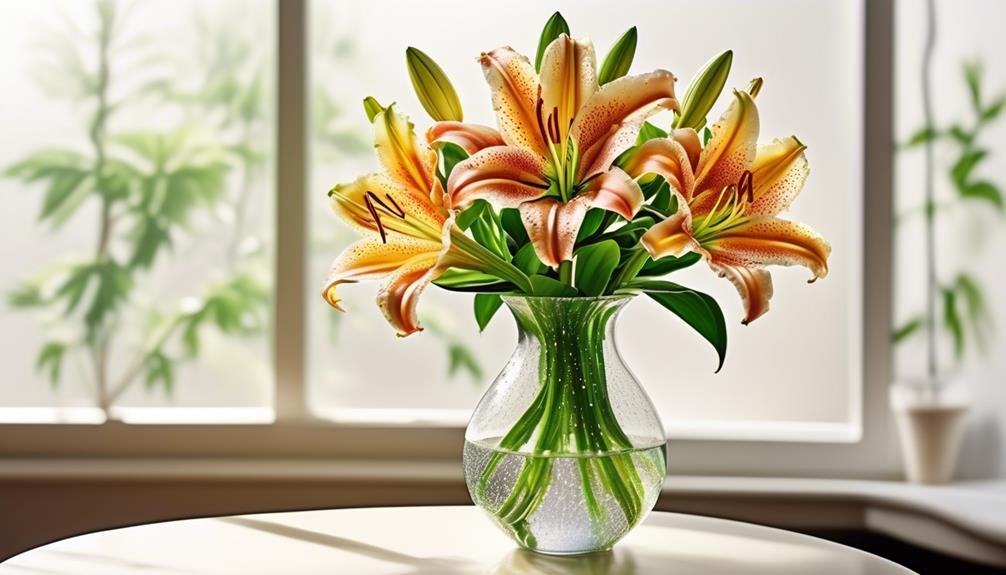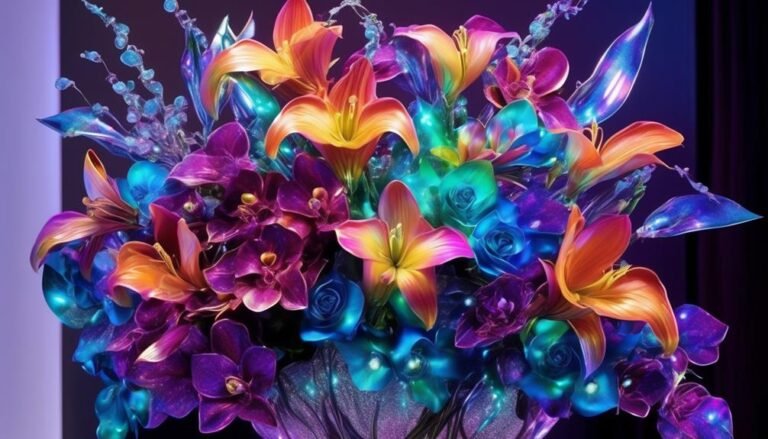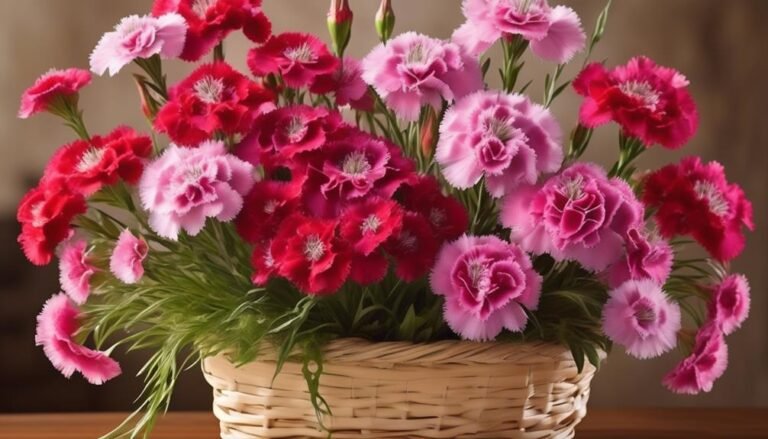Popular Types of Florist Flowers – Lily
Lilies are a popular choice among florist flowers due to their graceful allure and deep cultural significance. They belong to the genus Lilium and are known for their vibrant colors and elegant form. Lilies have been revered for centuries and are associated with various cultural and religious meanings.
There are numerous varieties of lilies available, each with its unique characteristics. Some common types include the Asiatic lilies, which come in a wide range of colors, the elegant Calla lilies, and the fragrant Oriental lilies. These varieties offer a diverse selection for floral arrangements and garden displays.
Lilies come in a spectrum of colors, each with its symbolic meaning. For example, white lilies symbolize purity and virtue, while pink lilies represent prosperity and abundance. Yellow lilies are associated with gratitude and happiness, and orange lilies symbolize passion and confidence. The color symbolism adds a layer of depth and sentiment to floral gifting and decor.
Caring for lilies involves providing them with well-drained soil, ample sunlight, and regular watering. It's essential to remove the pollen-bearing anthers to prevent staining and to prolong the lifespan of the blooms. With proper care, lilies can thrive both indoors and outdoors, adding beauty and elegance to any space.
In conclusion, lilies are a beloved choice in the world of florist flowers, offering a rich tapestry of colors, meanings, and varieties. Understanding their cultural significance and care requirements enhances the appreciation for these timeless blooms, making them a delightful addition to any floral collection.
Scientific Name
Lilies, scientifically known as Lilium, belong to the Lilium genus, a crucial classification for understanding the diverse species and hybrids within this group. Initially classified under the Liliaceae family, lilies were later reclassified under the Lilium genus, reflecting their genetic and morphological characteristics. This precise classification system aids botanists and horticulturists in identifying, naming, and organizing the multitude of lily species and hybrids.
Lilies hold various symbolic meanings across different cultures, representing purity and virtue in Western societies and symbolizing good luck and abundance in Eastern cultures. The scientific name Lilium encapsulates this profound symbolism, encompassing the essence of these beliefs and values associated with lilies.
Understanding the scientific name Lilium is crucial for comprehending the vast array of lily species and hybrids, serving as the foundation for categorizing and organizing these botanical marvels. Delving into the history of taxonomy and acknowledging the symbolism and cultural significance further enriches the appreciation for lilies as both beautiful flowers and deeply meaningful entities.
Background History
Lilies have been deeply intertwined with the historical and cultural tapestry of various civilizations, carrying profound symbolic importance and diverse meanings.
- Symbolic Significance
Lilies hold symbolic importance across Greek, Chinese, Assyrian, Babylonian, and Christian cultures, with different colors representing distinct meanings. They symbolize rebirth, motherhood, good luck, long-lasting love, fertility, and devotion.
- Cultural Importance
Integral to religious and cultural ceremonies, lilies symbolize purity, grace, majesty, and honor. They're also associated with sympathy, making them popular choices for funeral flowers. In Christianity, lilies are linked to the Virgin Mary, further enhancing their cultural significance.
- Timeless Legacy
Lilies have maintained their enduring legacy, from ancient civilizations to modern traditions. Their profound symbolism and diverse meanings have solidified their position as a timeless and cherished flower with deep cultural roots. Throughout history, lilies have been revered for their beauty and symbolism, preserving their significance across generations.
Physical Description

Lilies, from the genus Lilium, are known for their tall, upright stature and striking trumpet, bell, or bowl-shaped flowers. They come in a wide array of colors and patterns, excluding blue, and some varieties are fragrant while others are not. The six-petaled blooms and six anthers of true lilies contribute to their symbolic significance, representing purity, virtue, and renewal in various cultures and religions.
In art and culture, lilies are often depicted in religious paintings and symbolism, making them a popular choice for floral arrangements, wedding bouquets, and ceremonial decorations. The combination of their aesthetic appeal, symbolic significance, and rich cultural history makes lilies a captivating subject in both the botanical and artistic realms.
Colours and Characteristics
Lilies come in a variety of colors, each with its own symbolic meaning, making them a versatile choice for floral arrangements. Understanding the emotional significance of different colored lilies can add depth to the message conveyed through these beautiful flowers.
Here are the symbolic meanings of different colored lilies:
- White Lilies: Symbolize purity, virtue, and innocence. They're often used in weddings to represent the purity of the bride and are also used to express sympathy and convey a sense of peace and tranquility.
- Orange Lilies: Associated with confidence and wealth, they're often given to celebrate accomplishments and milestones, conveying pride and admiration for the recipient.
- Red Lilies: Represent passion and love, making them a bold declaration of romantic feelings and deep emotional connections.
Lilies not only offer physical beauty but also carry rich symbolic meanings attached to their different colors. Whether it's to celebrate an achievement, express love, or convey sympathy, lilies provide a wide range of options to communicate heartfelt emotions through their vibrant hues and emotional significance.
Varieties Available

When it comes to lilies, there are various varieties to explore, each with its own unique characteristics and growing preferences. Asiatic lilies are known for their easy cultivation and come in a wide range of colors, making them versatile for different arrangements. Martagon lilies, also called Turks Cap lilies, thrive in cooler climates and shaded areas, offering a distinct option for specific growing conditions. Their elegant downward-facing blooms add a unique touch to garden beds and bouquets.
Candidum lilies feature fragrant white petals with yellow bases, adding a classic and elegant touch to floral designs and bouquets. They're often chosen for weddings and religious ceremonies due to their symbolism of purity and virtue. American lilies bloom in mid-summer with vibrant upward-facing flowers, making a bold statement in garden borders and mixed floral arrangements.
Longiflorum lilies, also known as Easter lilies, are popular for holiday arrangements and decor. Their large white blooms hold symbolic associations with purity, renewal, and the cycle of life, making them a common sight during Easter celebrations.
Understanding the unique characteristics and symbolism of each lily variety can help you choose the perfect options for your floral arrangements and garden landscapes.
Seasonal Availability
Seasonal availability of lilies is a crucial factor for the floral industry and consumers alike. Let's explore how it impacts the local economy and how climate change is influencing this aspect.
- Local Economy: The seasonal availability of lilies significantly impacts the local economy, especially in regions where lily cultivation is a major industry. Peak seasons bring high demand, generating substantial revenue and providing employment opportunities. Conversely, off-peak seasons may lead to reduced income for lily growers and distributors, potentially affecting the overall economic stability of the community.
- Impact of Climate Change: Climate change has the potential to disrupt the traditional seasonal availability of lilies. Shifts in temperature, rainfall patterns, and extreme weather events can directly impact the growth and blooming cycles of lilies, leading to irregular availability and affecting pricing dynamics. This may also necessitate adjustments in cultivation practices, potentially increasing production costs and influencing market prices.
- Consumer Considerations: Understanding the seasonal availability of lilies is essential for making informed purchasing decisions. Being aware of peak and off-peak periods can help in planning events and may also influence budgeting for floral arrangements.
Care Tips

Lilies are stunning flowers that can be easily incorporated into DIY bouquets with complementary flowers like roses or baby's breath for a beautiful floral display. To ensure the longevity of your lilies, it's important to follow these care tips:
Trimming and Arranging:
- Trim the stems diagonally before placing the lilies in a clean vase filled with room temperature water.
- Remove any leaves that would be submerged in the water to prevent bacterial growth.
- Consider removing the stamens from the lilies to prevent pollen stains and extend their pristine appearance.
Maintenance:
- Consider adding flower food to the water in the vase to provide essential nutrients for the lilies.
- Top up the vase with fresh water regularly and change the water every few days to maintain the lilies' freshness.
Allergies:
- If allergies are a concern, choose unscented lily varieties to avoid triggering allergic reactions.
Are Sweet Pea Flowers Similar to Lilies in Terms of Popular Use in Floristry?
Sweet pea flowers and lilies are popular types of florist flowers that are frequently used in floral arrangements. While both flowers are beloved for their beauty and elegance, they are quite different in appearance and scent. Sweet peas are known for their delicate, fragrant blossoms, while lilies are admired for their bold, elegant blooms.
Conclusion
Lilies are a versatile and meaningful addition to any floral arrangement, with their various colors representing different qualities and emotions. They're popular for weddings, funerals, and special events due to their historical significance and cultural symbolism.
Lilies are associated with rebirth, motherhood, and good luck, making them a cherished and timeless flower in the world of floristry. With proper care, lilies can last a long time, bringing beauty and elegance to any occasion.






